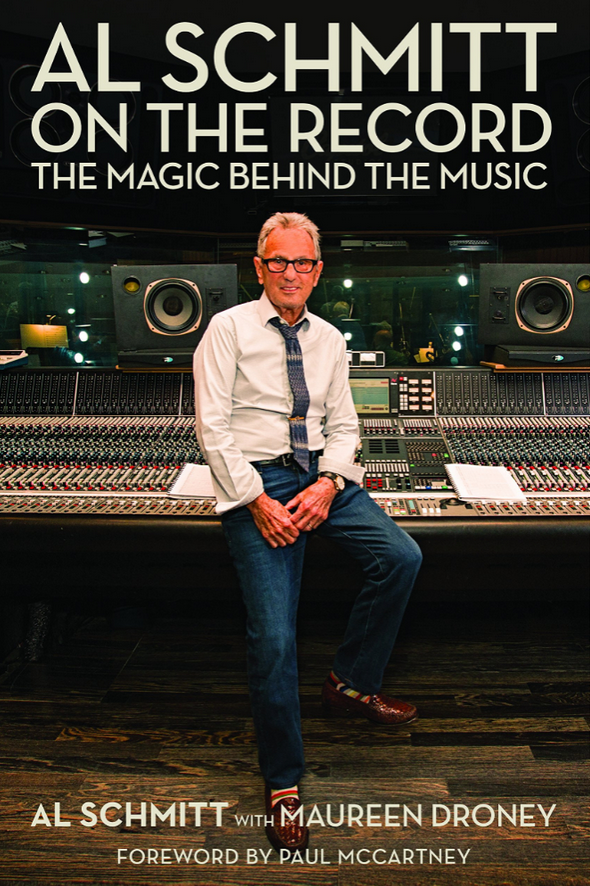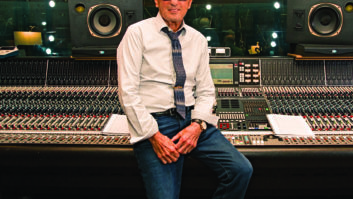
If you read Al Schmitt On the Record: The Magic Behind the Music, the revered engineer’s new autobiography will weave its own spell on you. The recipient of more than 20 Grammy Awards, Schmitt also has two Latin Grammys, a Recording Academy Lifetime Achievement Award, a star on the Hollywood Walk of Fame (the first ever for an engineer) and more than 160 Gold and Platinum recordings to his credit. Those were earned while working with generations of the musical elite, from Frank Sinatra and Henri Mancini, to Paul McCartney and Barbra Streisand, to Dr. Dre and Lady Gaga. You can also find his name on albums by Bob Dylan, Sam Cooke, Toto, Diana Krall, Steely Dan, Luis Miguel, Norah Jones, George Benson, Natalie Cole, Quincy Jones, Jackson Browne, Neil Young, Tony Bennett and Jefferson Airplane, to namedrop only a few. That’s plenty of material for a book, and Schmitt doesn’t disappoint as he recounts not only his epic career, but what he’s learned along the way.
Written with Maureen Droney, managing director of the Recording Academy’s Producers & Engineers Wing, the book has plenty of recording insights, gear opinions and technical tips, but it often takes a broader view, looking at what’s required on a personal level to stay at the top of your game for decades. As a result, Schmitt discusses how he’s benefited from meditation, for instance, but he also doesn’t shy away from difficult topics like what led to attending his first AA meeting nearly 30 years ago.
Schmitt starts the book with a bang, recalling the session that launched him into the big time. As a 19-year-old studio apprentice in Manhattan, he learned on the job until he was permitted to record demos on his own. Things went fine until a weekend session, booked under the name “Mercer,” turned out to be Duke Ellington and his big band, which included greats like Billy Strayhorn and Johnny Hodges. Panicked, Schmitt tried to make the most of the eight inputs available, setting up mics using sketchy placement diagrams he’d hastily drawn while assisting on other sessions. He told Ellington “I’m not qualified” so often that eventually the jazz great had to calmly reassure him that he could do it. And he did.
Ellington wasn’t the only one to encourage Schmitt over the years, and now the producer/engineer himself takes on a mentoring role with the book, showing readers via his stories how to prep, run and maintain control of a session. (One tale, regarding Al Jarreau, is a laugh but also particularly instructive.) Throughout, he shares advice freely and keeps it mighty real. Case in point: In a section titled “Top 11 Things Assistant Engineers Need to Know,” topics range from being well-versed in DAWs to looking after personal hygiene, because “nobody wants to spend 10 or 12 hours in a small control room with someone who smells like an old goat.”
Schmitt often gets satisfyingly technical, too, yet never turns his autobiography into a textbook. When he digs deep into microphones, you learn his preferred choices for different instruments as he discusses ideal placement, polarities, leakage, Decca trees, tips for recording vocals and more. Elsewhere, he takes apart his mixing process and philosophy, and in one of three appendices, unearths recording session layout diagrams detailing how studios were set up for seven of his most famous projects. But just as much gold can be found in chapters like “Life’s Been Good to Me So Far: Life Lessons and the Secrets to My Success,” in which Schmitt shares insight about how to conduct yourself both in the studio and in life, speaking from hard-won experience.
Schmitt and Droney have written an expansive, wide-ranging, ambitious book that does far more than merely catalog the past. As a result, Al Schmitt On the Record is one of those tomes that belongs on the shelf in every studio, whether for quick reference or quick inspiration, destined to acquire multiple dog-eared pages and its share of coffee cup rings on the cover from repeated reads over the years. It’s that essential.
Al Schmitt • https://www.alschmittmusic.com







